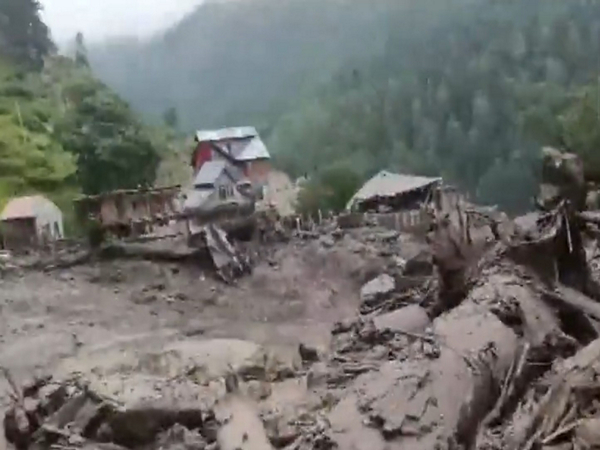A Pilgrimage Turned Tragic
By: Javid Amin | 15 Aug 2025
What began as a sacred journey to the Machail Mata shrine in Kishtwar turned into one of the deadliest tragedies in recent years in Jammu & Kashmir. On Thursday afternoon, August 14, 2025, massive flash floods tore through Chasoti (also spelt Chisoti) village, leaving a trail of destruction and grief.
At least 60 lives have been confirmed lost, most of them pilgrims. Many more are feared missing as rescue teams scour debris-strewn valleys for survivors.
For those who lived through it, the memories are as vivid as they are haunting — sounds, sights, and emotions etched permanently into their minds.
“Like a Bomb Exploding” – Voices from the Ground
Shalu Mehra, a pilgrim who had just reached Chasoti, recalls the exact moment disaster struck:
“Suddenly, there was a sound like a bomb exploding, and everyone started shouting ‘run, run.’ I began to run but got trapped in the debris. An electricity pole fell on my head. I shouted for my daughter, and she pulled me out.”
Her escape was only half the battle. Even as she freed herself, her thoughts were with her son — 7 km ahead on the yatra route. She began searching frantically, navigating through chaos and destruction.
The Community Kitchen That Became Ground Zero
The Machail Chishoti Langar — a large community kitchen feeding pilgrims — became one of the worst-hit spots. Sanjay Kumar, 42, was among those inside when the flood struck.
“Some pilgrims were eating, others had come in to shelter from the rain. Suddenly, a flash flood carrying debris hit the kitchen. Everything flattened in seconds. Vehicles outside — four of them — toppled like toys and were swept away. I survived by a miracle.”
Kumar sustained fractures in both legs and now lies in hospital, still trying to process the scale of the disaster.
“Screams Followed by Silence” – A Langar Head’s Ordeal
Subhash Chander Gupta, head of the community kitchen, said the floodwaters arrived with terrifying speed:
“We were serving lunch. Then came a roar — boulders, trees, soil, all in one furious wave. There was no time to think. I heard screams all over, then a deafening silence.”
Gupta was pinned under a huge boulder as mudslides passed over him. He remained trapped for more than three hours before being pulled out by rescuers.
How the Disaster Unfolded
The flash floods struck around midday, when hundreds of devotees were gathered at Chasoti, the starting point of the final 8.5-km trek to the Machail Mata shrine.
Heavy rain upstream triggered a surge in the local stream, which quickly turned into a torrent of water, mud, and debris. Temporary structures — including the langar shed — were swept away. Vehicles, tents, and even parts of pathways vanished in minutes.
The Casualty Count and Rescue Efforts
-
Confirmed dead: 60 (mostly pilgrims)
-
Missing: Several dozen, exact figure still uncertain
-
Rescue teams on ground: NDRF, SDRF, Army, police, local volunteers
-
Control room: Established in Paddar to coordinate search and relief operations
The terrain poses major challenges — roads are blocked by landslides, and continued rain raises the risk of further flooding. Despite this, rescuers are working round-the-clock, often with bare hands, to search under rubble and mud.
Why This Happened – The Cloudburst Factor
Meteorological experts believe the floods were triggered by a cloudburst — an intense, localized rainfall event in which over 100 mm of rain falls in less than an hour. In the steep valleys of Kishtwar, such rainfall has nowhere to go but downhill — at devastating speed.
Factors worsening the impact:
-
Unplanned pilgrim facilities built too close to river channels
-
Blocked drainage due to construction and debris
-
Deforestation and slope destabilization in the area
The Road Ahead – Recovery and Lessons
Even as rescue work continues, the focus will soon shift to:
-
Identifying the missing and reuniting families
-
Providing relief and compensation to survivors
-
Rebuilding infrastructure destroyed in Chasoti
-
Reassessing safety measures for the Machail Mata Yatra
Experts stress that early warning systems, strict zoning, and weather-linked route closures could prevent similar tragedies in the future.
Conclusion – Faith in the Face of Fury
The Kishtwar flash floods have tested the resilience of pilgrims, rescuers, and local communities alike. For many, this year’s Machail Mata Yatra will be remembered not for its spiritual destination, but for the sheer force of nature and the human courage it brought to light.
Amid the mourning, there is also determination — to rebuild, to honor the lost, and to ensure that devotion is never again met with such devastation.



